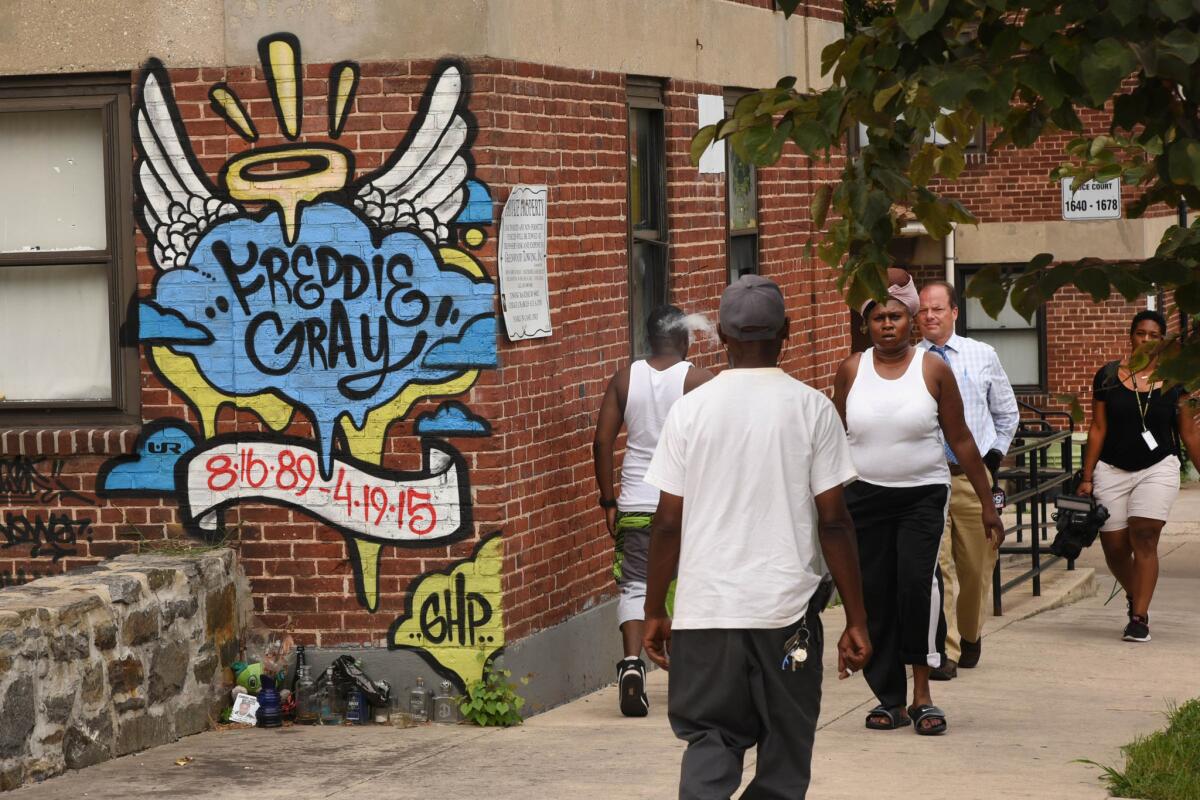In Freddie Gray’s neighborhood, mixed reactions to new guidelines for Baltimore police

- Share via
Reporting from BALTIMORE — In the West Baltimore neighborhood where Freddie Gray was arrested, Leanda High saw progress against police abuse and harassment in a federal order calling for sweeping changes to the Baltimore Police Department.
But she also saw complications.
Perhaps now, she said, police won’t curse at black men, force them to show a driver’s license when they’re walking down alleys or treat people with disrespect, even physical abuse.
Under the consent decree, a 227-page list of guidelines from the Department of Justice, Baltimore officers will be required to call their supervisors before arresting someone for shooting craps, disobeying officers, making false statements or trespassing.
But High, 56, said that also means officers must jump through another hoop before chasing away the drug sellers on her North Fulton Avenue block. She closed down her home day care two years ago, because, she said, parents were too scared of the dealers to come by.
The consent decree announced Thursday was a rare step by Justice Department officials to curb patterns and practices they believe led to civil rights violations. (A day later, the Justice Department released a damning critique of the police force in Chicago.) The Baltimore decree was issued after the city had paid millions of dollars in civil settlements for alleged abuses or unnecessary force by officers.
At the national forefront of such incidents was the April 2015 arrest and death of Gray, which set off weeks of protests and unrest.
In the Sandtown-Winchester neighborhood Gray hailed from, the federal order was met with relief and gratitude, but also skepticism and concern. The neighborhood is the city’s most violent — leading in total shootings last year. And it’s widely considered the neighborhood in which relations between police and the community need the most repair.
On Friday, High stood on the steps of her row house and reflected on the task police face — retraining officers on how to interact with the public, while also trying to suppress violence in a city that saw more than 300 homicides in each of the past two years. Within view of her home is a large mural depicting Gray’s face, demonstrators holding signs and a scroll listing others killed in interactions with Baltimore police.
“Most of all, it says be respectful and get to know your community,” High said of the consent decree. “I don’t think we’re asking a lot.”
Her grandmother owned the row house High lives in, and she remembered a time when everyone knew the beat cop who walked by twirling his baton, and teens grew up looking up to officers who supervised the Police Athletic Leagues they played in.
It’s that interaction, she said, that’s missing, and she hopes the consent decree pushes officers and youths to get to know each other better. Her interactions with police have been mostly positive, and she said she sees progress with younger police hires, who seem more polite and willing to talk to residents.
But she also said she has heard homeowners complaining recently that officers tell them they can’t do anything when they ask police to shoo people loitering outside their homes if there is no observable crime.
“Homeowners who don’t want people hanging around really can’t get rid of them,” High said. “But they can’t come and tell them to leave the front.”
Balancing civil rights while also responding to homeowner complaints and suspicions will be just one of the many challenges police are facing because of the decree.
Outside a nearby corner store, Shaun Young, 28, laughed skeptically at whether the consent decree would stop officers from constantly stopping him.
Most recently, he said, he was arrested for disturbing the peace for filming another person getting arrested as part of Baltimore Copwatch. The charge was dropped, he said.
“What basically happens is that they said there’s a procedure that has to be in place that police have to follow,” he said. “But the reason that they put these procedures in place is because police weren’t following procedures.”
Young also doesn’t want to see police chase him off corners. Rather, he wants to see more of them on foot patrol so he can be safe and hang out in his neighborhood.
Mechille Shaw, 38, who has lived in Sandtown-Winchester for 26 years, said she understands the complexity of policing in her neighborhood.
“In order to get respect, you got to give it,” she said.
She’s seen officers yelling at people to get off a corner, the officers’ comments spiked with profanity. That, she said, doesn’t earn police any respect.
“They don’t ask why you’re on the corner, they just assume you’re either buying drugs or selling drugs, and that’s not necessarily true,” she said.
Grandfathers, mothers and working people wait around at bus stops, she noted, but so do drug dealers. Police need to work on being more selective, she said, just as some young adults need to understand that police are doing a needed job.
“Hopefully we can go back to the way it was when we were raised to respect the police,” she said. “It should go both ways.”
George writes for the Baltimore Sun.
ALSO
Justice report rips Chicago police for excessive force, lax discipline, bad training
Trump kicks off Martin Luther King weekend by sharply criticizing civil rights icon John Lewis
Majority of police in the U.S. say their jobs have gotten harder
More to Read
Sign up for Essential California
The most important California stories and recommendations in your inbox every morning.
You may occasionally receive promotional content from the Los Angeles Times.










